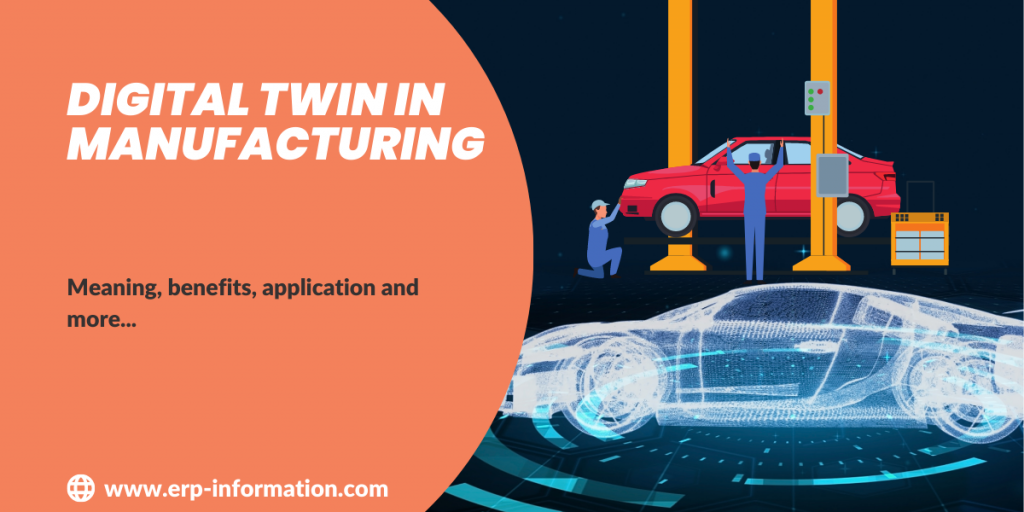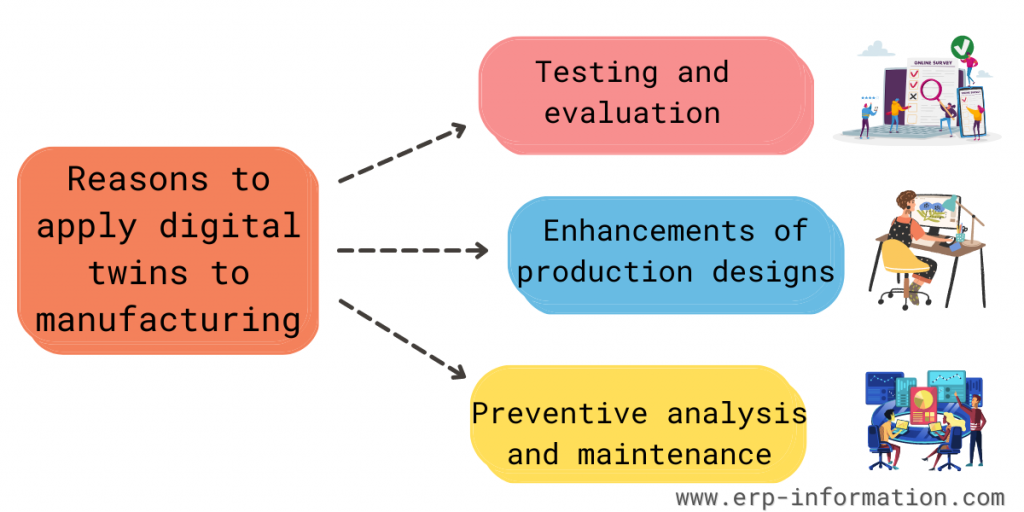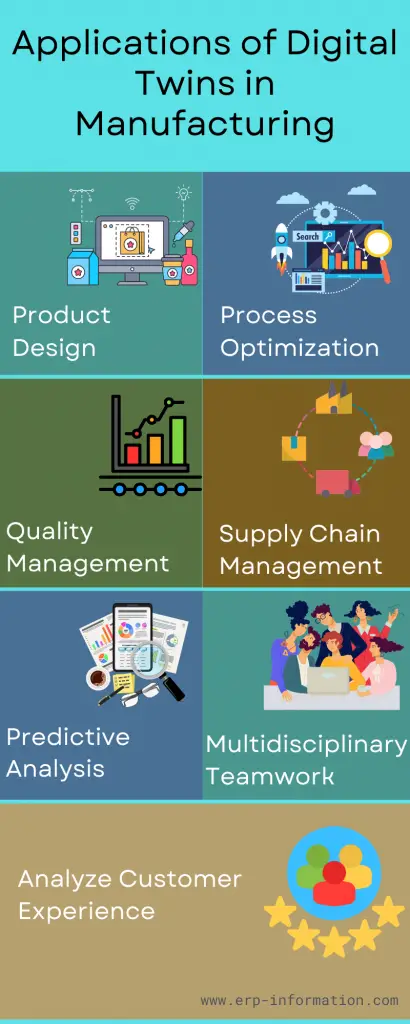It would be advantageous if the manufacturers detected irregularities and probed them to develop better products.
With the factories and manufacturing units adapting digital technologies to run their operations, digital twinning covers the way for them to revamp their products and enhance their process, product quality, and cost-effectiveness.
Any industry involved with manufacturing can use digital twin technology, including aerospace, automotive, medical devices, construction, agriculture, etc.
This blog post will provide complete information about the digital twin in manufacturing, its benefits, reasons to use it, its application process, and more.
What is a digital twin?
A digital twin is a virtual or digital representation of a product, process, or system that extends across its product lifecycle from its idea creation, production, operations, and sales.
It serves as the digital model of the actual version for running simulations, evaluating, supervising, and servicing it.
The digital twin operates in real time and adopts simulation, predictive analysis, and reasoning for managing the product or process.
What is digital twin in manufacturing?
Digital twin in manufacturing helps humans foresee how the physical version of the product will perform in real-time in different scenarios under varying conditions with its interactional capability. It also provides the complete analysis and details of the product in the physical world.
Data collection for conceptualization is carried out with the help of both mixed and artificial environment tools and smart sensors, trackers, software, and other IoT applications for precisely indicating the presence of the process or product at any specific time in the manufacturing unit as in the physical world.
Digital twin in manufacturing enables a digital twin to be adjusted to an entire manufacturing process or line and a particular module or unit. Manufacturing processes involve various operations with multiple prerequisites and modus operandi definitive to their production procedures.
Here, digital twin technology aids industries and their manufacturing heads by resulting in exclusive outcomes regarding that manufacturing setup.
The digital twin technology can be used at different levels by manufacturers to aid their operations :
- Component level: Here, it is focussed on a very vital component being used in the production process
- Asset level – Virtual modeling of particular machinery used in the assembly line
- System level – Using IoT to inspect and upgrade the complete assembly line.
- Process level – This involves the virtual imagery of the idea being conceptualized right from design, processing, mass production, marketing, and sales. It covers the entire product life cycle and includes consumer product use and subsequent developmental activities.
Reasons to apply Digital twins in manufacturing
Testing and evaluation
Testing and determining faults in the simulation models is easier for the production team to track defects and updates.
Enhancements of production designs
The entire team can coordinate on bringing in modifications in the virtual process of assembly lines to fine-tune and enhance the operations before building and applying it in the physical model.
Preventive analysis and maintenance
IoT devices monitor all the process details throughout the event in real time. It keeps track of the equipment and machinery being used. It saves this data on a centralized domain enabling the persons in charge to inspect irregularities and malfunctioning and tends to them.
Benefits of digital twin in manufacturing
With the arrival of the fourth industrial revolution, smarter technologies have taken over to increase production and profits. As a result, Digital Twin technology has several benefits to offer. Benefits of digital twin in manufacturing include:
Improved productivity
Optimizing operations by identifying issues through simulated models lead to better production efficacy.
Improved performance and reliability of machinery
Maintaining resources through predictive analysis is made significantly simpler with real-time monitoring of the machinery and equipment powering production lines.
This technology can anticipate potential problems before they arise, allowing for proactive maintenance to keep operations running smoothly.
High-quality production and customer satisfaction
Digital twin technology enables manufacturers to produce top-quality products. It visualizes its products through prototypes and manages its operations as per standards. Thereby gaining approval from the customers for the product quality.
Cost-effective
Real-time monitoring and predictive analysis help save on the finances of the entire process. With the digital prototype giving an insight, it saves on raw materials, staff, running costs, etc. Also, the manufacturers can keep a check on repair and refitting expenses.
Improved efficiency
The efficiency of the manufacturing unit improves with the employment of Digit twins. This enables them better control supply, logistics, and delivery networks.
Applications of digital twin in manufacturing
Product design
In this phase, a digital replica of the product is created and manipulated to evaluate various variables and designs before creating the physical model.
This proves to be a cost and time-effective solution to begin manufacturing the product.
Process optimization
Actuators and sensors are employed on the assembly line to generate a digit twin of the entire process to measure and analyze the performance.
The following results can be altered to optimize processing, perform a critical analysis, and decrease the discrepancies.
Quality management
The data from the sensors and other IoT devices is monitored and analyzed in real-time to maintain quality in production and dispose of any anomalies.
The digital twin creates a virtual model of the entire process to determine where anomalies occur and how to modify the use of materials and processes.
Supply chain management
Here, digital twins are used to track and evaluate important performance indicators such as fleet management, route efficiency, packaging, etc. They help in the optimization of manufacturing processes and distribution routes.
Predictive analysis
Digital twins for machinery and manufacturing processes use predictive analysis to monitor defects arising for repairs or servicing purposes before any breakdowns result, optimization of load levels, calibrating instruments, and cycle times are possible.
Multidisciplinary teamwork
Digital twins provide ample workable data, which helps people from departments and disciplines collaborate. It aids decision-making and communication across the engineering division, manufacturing team, and sales and marketing personnel.
Analyze customer experience
Over time, data collected by digital twins assists in understanding product performance, distribution, and purchaser experience.
Engineers and designers can use this information or feedback to enhance the customer response by making it user-friendly and giving personalizations.
Some examples of digital twin in manufacturing
Example 1
Every Tesla product has a virtual version of itself created from the data collection from IoT devices mounted on the vehicles.
This data is stored in the cloud, allowing the company to evaluate its performance through AI software, determine the possibility of it malfunctioning, and reduce the possibility of being taken for repairs and servicing.
It increases its repurchase chances by reducing the company expenses on car maintenance of those under warranty period. Thus, providing a better customer experience.
Example 2
Unilever PLC has adopted digital twin technology to increase the effectiveness of the production process and make it responsive.
The sensors installed at every site deliver real-time performance info like humidity, temperature, and motor speed onto the cloud. In addition, a digital twin is generated using analytics and intelligent systems, and various scenarios are simulated to select the apt operational conditions.
These simulations help manufacturers promptly use the materials and resources and curb wastage to meet quality standards.
Example 3
The pharma industry collaborates with Siemens and Atos to employ digital twin technology. This system creates a digital replica of a particular production step, and the IoT devices in the process plant provide real-time insight into the operational details.
Advanced analytics and AI algorithms present optimization solutions to improve process quality and reliability.
FAQs
How does Digital Twin in Manufacturing improve productivity?
By providing a virtual representation of physical assets, processes, and systems, Digital Twins enables manufacturers to monitor performance, identify inefficiencies, and optimize operations in real-time, resulting in increased productivity and cost savings.
Can Digital Twins help in reducing maintenance costs?
Yes, Digital Twins facilitate predictive maintenance by continuously monitoring equipment condition and performance. By predicting potential failures before they occur, manufacturers can schedule maintenance activities proactively, minimizing downtime and reducing maintenance costs.
Conclusion
Digital Twin technology in manufacturing is growing exponentially with its strong foundation for researching and developing a product under consideration.
Furthermore, the virtual replica created through digital twin technology aims to optimize the use of materials, manufacturing processes, design aspects, and customer satisfaction.
With further advancements in this technology, manufacturing will run efficient production lines and be profitable simultaneously.


